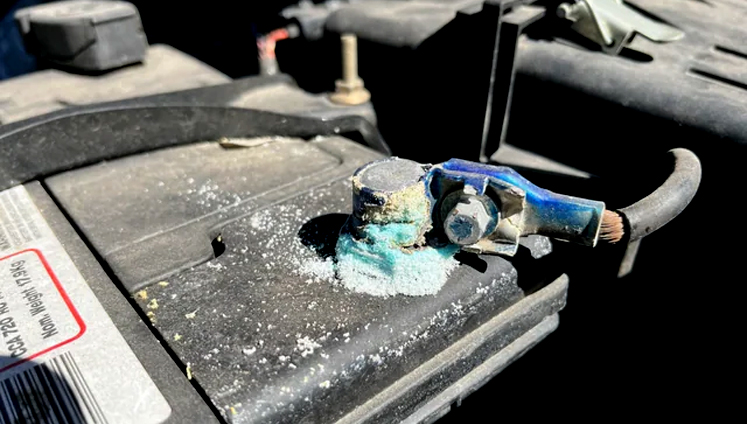
Battery Terminal Corrosion in Automotive Batteries: Causes, Effects, and Solutions
Introduction
Corrosion or buildup on battery terminals is a common issue that significantly affects the performance and lifespan of automotive batteries. Battery terminals, which serve as the connection points between the battery and the vehicle’s electrical system, play a critical role in current transmission. Any corrosion in this area can disrupt the flow of electricity and lead to various operational problems.
1. Causes of Terminal Corrosion
Chemical reaction between electrolyte and metal
Automotive lead-acid batteries contain sulfuric acid. Vapors or minor leaks from the electrolyte can react with lead or copper at the terminals, leading to the formation of compounds such as lead sulfate or metal oxides.
Corrosion due to environmental exposure
Battery terminals are exposed to moisture, heat, and acidic gases, which can cause corrosion. This typically appears as white, gray, or blue-green deposits on or around the terminals.
Loose connections
Poor or loose connections at the terminals may generate sparks and heat, which accelerate oxidation and corrosion buildup.
Electrolyte leakage
In conventional batteries, there is a risk of electrolyte leakage, especially around the terminals, which contributes to corrosion and structural damage.
2. Effects of Corrosion on Battery Performance
Increased electrical resistance
Corrosion creates resistance in the electrical pathway, resulting in poor current flow. This resistance can reduce the battery’s ability to deliver sufficient power, making it harder to start the engine.
Reduced battery output
Corroded terminals prevent the battery from efficiently delivering electricity, causing voltage drops and diminished output.
Premature battery failure
Over time, corrosion leads to weak connections or even arcing, which can cause the battery and electrical components to fail prematurely.
Damage to cables and surrounding components
Corrosion can spread from the terminals to the connected cables and nearby metal parts, leading to broader electrical damage.
3. Identifying Terminal Corrosion
-
Visible white or blue-green buildup on terminals
-
Difficulty starting the engine due to increased resistance
-
Discoloration or degradation of nearby metallic parts
-
Abnormal voltage or current readings during diagnostic tests
4. Cleaning and Prevention Methods
Cleaning corrosion
Corrosion can be removed using a mixture of baking soda and water. Baking soda neutralizes the acid, and the terminals can be scrubbed clean using a soft wire brush or an old toothbrush. After cleaning, the area should be rinsed with water and thoroughly dried.
Using anti-corrosion grease
After cleaning, applying anti-corrosion grease to the terminals helps prevent future buildup and oxidation.
Ensuring proper connections
Secure and tight terminal connections prevent sparks and heat, reducing the chances of corrosion.
Periodic inspection
Regular inspection and cleaning, especially during cold and humid seasons, is crucial to prevent terminal degradation.
5. Importance of Addressing Terminal Corrosion
-
Prevents unexpected power loss and start-up issues
-
Prolongs battery lifespan and reduces replacement costs
-
Maintains the overall health of the vehicle’s electrical and electronic systems
Conclusion
Terminal corrosion is a key factor in declining battery performance and shortened lifespan. By understanding its causes and taking preventive measures—such as regular cleaning and using protective materials—battery efficiency can be improved, and potential issues can be avoided. Proper care of battery terminals is an essential part of overall vehicle maintenance.
